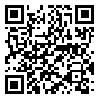Volume 38 - Continuously Updated- In press
IJN 2025, 38 - Continuously Updated- In press : 0-0 |
Back to browse issues page
Download citation:
BibTeX | RIS | EndNote | Medlars | ProCite | Reference Manager | RefWorks
Send citation to:



BibTeX | RIS | EndNote | Medlars | ProCite | Reference Manager | RefWorks
Send citation to:
Kamalinia M, Zahrakar K, Arabzadeh M. Developing a Structural Equation Model of Resilience in Female Nurses: The Effect of Cognitive Flexibility and Self-Differentiation with the Mediating Role of Intimacy and Marital Adjustment. IJN 2025; 38 (S1 )
URL: http://ijn.iums.ac.ir/article-1-3857-en.html
URL: http://ijn.iums.ac.ir/article-1-3857-en.html
1- Department of Psychology, Faculty of human science, Saveh Branch, Islamic Azad University, Saveh, Iran.
2- Department of Counseling, Faculty of Psychology and Educational Sciences, Kharazmi University, Karaj, Iran. ,dr_zahrakar@gmail.com
3- Department of Psychology, Faculty of Psychology and Educational Sciences, Kharazmi University, Karaj, Iran.
2- Department of Counseling, Faculty of Psychology and Educational Sciences, Kharazmi University, Karaj, Iran. ,
3- Department of Psychology, Faculty of Psychology and Educational Sciences, Kharazmi University, Karaj, Iran.
Abstract: (14639 Views)
Background and Aim:Resilience is known as a component that plays an important role in tolerating the hardships of the occupational and marital environment. Therefore, it is identified as the main construct of personality, so identifying variables that can predict resilience is important. This study aimed to develop a model for resilience using cognitive flexibility and self-differentiation by mediating intimacy and marital adjustment variables.
Materials and Methods:The present study is a fundamental study in terms of the purpose and the method of collecting descriptive data with correlation type with structural equation model. The statistical population of the study included all married female nurses in public health centers and hospitals of Albzand province, among whom 400 people were selected by multistage cluster sampling method from Karaj. Resilience, cognitive flexibility, self-differentiation, intimacy and marital adjustment questionnaires were used to collect data. To analyze the data, structural equation modeling test and SPSS software version 26 and Amos version were used to analyze the data. The results show that the data fit with the conceptual model of the research. Also, the mediating role of intimacy and marital adjustment between cognitive emotion regulation and self-differentiation on resilience was confirmed.
Results: The mean and standard deviation of self-differentiation was 87.6±26.75. The highest mean and standard deviation in resilience was (74.6±26.98) and the lowest mean and standard deviation in cognitive flexibility was (56.6±21.21). The total variance was also 167.2. The correlation matrix between the variables showed that there was a positive and significant relationship between cognitive flexibility (r =0.729); self-differentiation (r =0.732); marital intimacy (r =0.712); marital adjustment (r =0.792) with resilience at the p>001 level. The indices (CFI); (AGFI); (IFI); (GFI), (NFI) were obtained as 0.938, 0.908, 0.915, 0.947 and 0.923 respectively, all of which are greater than 0.90 and indicate a suitable and desirable fit of the model. The value of the index (RMSEA) is also equal to 0.049, which, based on the Klein model, indicates the fit of the model.
Conclusion: According to the results of this study, it is suggested to the officials of the treatment staff to pay special attention to cognitive, emotional and emotional variables of this group to increase the resilience of married female nurses.
Materials and Methods:The present study is a fundamental study in terms of the purpose and the method of collecting descriptive data with correlation type with structural equation model. The statistical population of the study included all married female nurses in public health centers and hospitals of Albzand province, among whom 400 people were selected by multistage cluster sampling method from Karaj. Resilience, cognitive flexibility, self-differentiation, intimacy and marital adjustment questionnaires were used to collect data. To analyze the data, structural equation modeling test and SPSS software version 26 and Amos version were used to analyze the data. The results show that the data fit with the conceptual model of the research. Also, the mediating role of intimacy and marital adjustment between cognitive emotion regulation and self-differentiation on resilience was confirmed.
Results: The mean and standard deviation of self-differentiation was 87.6±26.75. The highest mean and standard deviation in resilience was (74.6±26.98) and the lowest mean and standard deviation in cognitive flexibility was (56.6±21.21). The total variance was also 167.2. The correlation matrix between the variables showed that there was a positive and significant relationship between cognitive flexibility (r =0.729); self-differentiation (r =0.732); marital intimacy (r =0.712); marital adjustment (r =0.792) with resilience at the p>001 level. The indices (CFI); (AGFI); (IFI); (GFI), (NFI) were obtained as 0.938, 0.908, 0.915, 0.947 and 0.923 respectively, all of which are greater than 0.90 and indicate a suitable and desirable fit of the model. The value of the index (RMSEA) is also equal to 0.049, which, based on the Klein model, indicates the fit of the model.
Conclusion: According to the results of this study, it is suggested to the officials of the treatment staff to pay special attention to cognitive, emotional and emotional variables of this group to increase the resilience of married female nurses.
Keywords: resilience, self-differentiation, cognitive emotion regulation, marital adjustmen, female nurses
Type of Study: Research |
Subject:
nursing
Received: 2024/11/25 | Accepted: 2025/03/21 | Published: 2025/03/21
Received: 2024/11/25 | Accepted: 2025/03/21 | Published: 2025/03/21
Send email to the article author
| Rights and permissions | |
 |
This work is licensed under a Creative Commons Attribution-NonCommercial 4.0 International License. |




